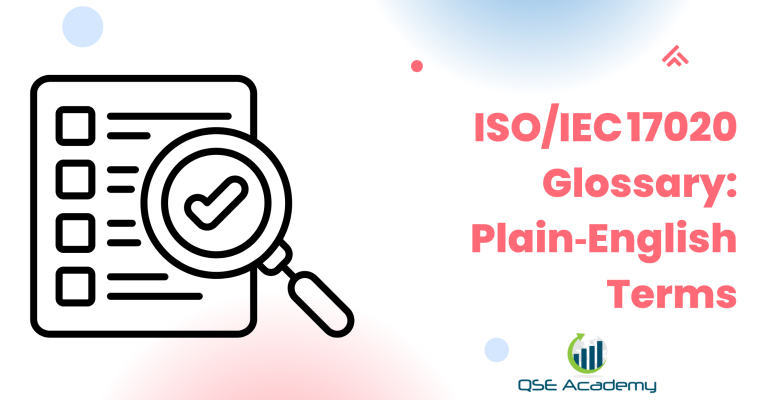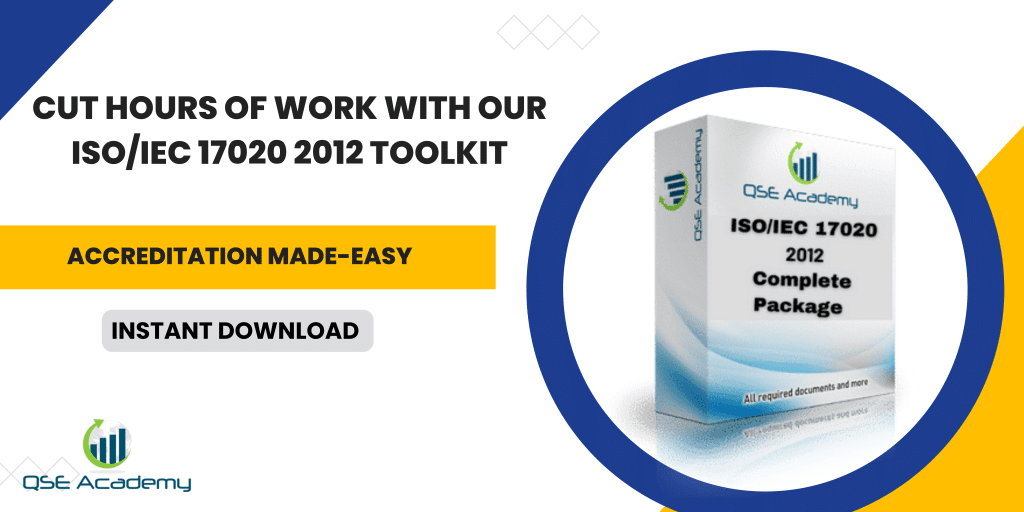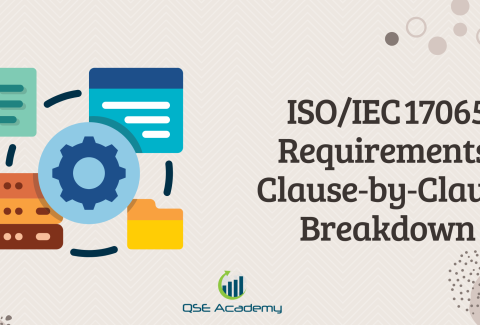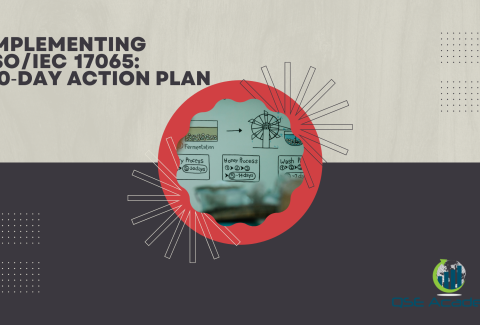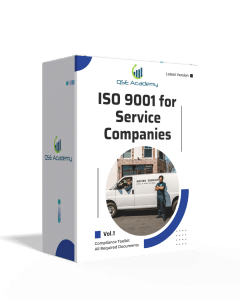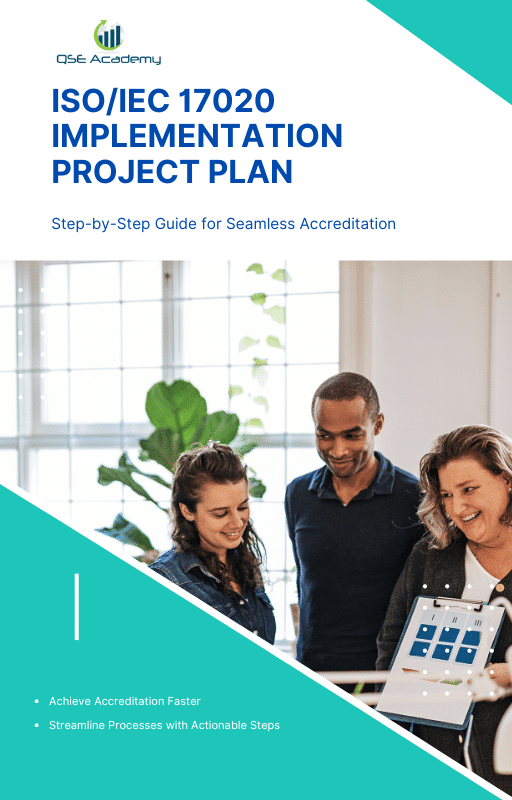ISO/IEC 17020 Glossary: Plain‑English Terms
Last Updated on October 22, 2025 by Hafsa J.
Making ISO/IEC 17020 Easy to Understand
If you’ve ever opened ISO/IEC 17020 and felt buried under technical language, you’re not alone.
I’ve seen highly experienced inspection managers, auditors, and engineers stumble over the same issue — the terminology. Words like impartiality, competence, or conformity assessment sound simple, yet in the context of the standard, they carry very specific meanings.
Here’s the challenge: most audit findings and implementation mistakes don’t come from poor systems — they come from misunderstanding what the clauses actually mean.
An assessor might ask about “authorization of inspectors,” and a team that uses the term differently internally ends up giving the wrong answer. The result? A preventable nonconformity.
That’s why I created this plain-English glossary.
Think of it as a translation guide between the technical language of ISO/IEC 17020 and the way inspection bodies actually work.
Each definition here is practical, stripped of jargon, and explained in everyday terms — so your team can communicate clearly, train confidently, and prepare for audits without confusion.
By the end of this guide, you’ll know exactly what the key terms in ISO/IEC 17020 mean, how they connect to your daily operations, and how to use them correctly when dealing with clients, regulators, or accreditation assessors.
Now, let’s start by understanding why clear terminology matters so much in an accreditation context.
Why Clear Terminology Matters in ISO/IEC 17020
Every inspection body that’s worked toward ISO/IEC 17020 accreditation eventually realizes this truth: clarity in terminology is half the battle.
You can have the best inspection procedures, competent staff, and top-tier equipment — but if your team doesn’t speak the same “language” as the standard, misunderstandings will keep tripping you up.
When assessors read your documents, they expect the terms in your quality manual, reports, and records to match what ISO/IEC 17020 actually means.
If you use audit when you mean inspection, or qualified when you should say authorized, you create gaps in interpretation that can easily lead to nonconformities.
Common Misunderstandings and How They Cause Problems
| Term Misused | Common Mistake | Correct Understanding |
|---|---|---|
| Inspection vs. Testing | Calling measurement-based testing “inspection.” | Inspection is judgment or evaluation; testing measures data (covered by ISO/IEC 17025). |
| Qualified vs. Competent | Assuming formal education equals competence. | Competence includes training, experience, and authorization to perform inspections. |
| Audit vs. Inspection | Using the words interchangeably. | Audits assess systems; inspections assess products, processes, or installations. |
| Verification vs. Validation | Treating both as the same activity. | Verification checks compliance; validation confirms suitability of a method. |
| Document vs. Record | Mixing up what’s controlled vs. what’s retained. | Documents guide work; records prove it happened. |
Why Clarity Saves Time and Prevents Audit Findings
When terminology is unclear, teams lose time explaining themselves — or worse, defending procedures that actually comply but were misinterpreted due to language.
A clearly written glossary and consistent vocabulary prevent these issues by aligning everyone — inspectors, managers, and assessors — around the same definitions.
It also improves training quality.
New inspectors learn faster when terms are explained in relatable, operational language rather than ISO clause wording.
That kind of clarity strengthens both competence and confidence during real inspections.
Key Insight
ISO/IEC 17020 isn’t just about doing things right — it’s about describing them correctly.
Shared understanding turns complex requirements into clear actions, reduces communication gaps, and keeps everyone audit-ready.
Core Accreditation Concepts – The Foundation Terms
Before diving into the more technical or operational terms, it’s essential to understand the core concepts that shape ISO/IEC 17020.
These are the words that appear throughout the standard — in policies, in procedures, and in every conversation with your accreditation body.
Once you understand these clearly, the rest of the requirements start to make sense.
Essential ISO/IEC 17020 Terms in Plain English
| Term | ISO/IEC 17020 Definition (Simplified) | Plain-English Meaning | Practical Example |
|---|---|---|---|
| Accreditation | Formal recognition by an official accreditation body that an organization is competent to carry out specific inspection activities. | It’s your organization’s proof of credibility — an external stamp of technical trust. | When a national accreditation body (like UKAS, IAS, or ENAS) approves your inspection scope after an assessment. |
| Inspection Body | An organization that performs inspection services. | Any entity that checks whether something meets requirements — could be a company, department, or agency. | A firm verifying weld quality, or a government unit inspecting elevators. |
| Inspection | Examination of a product, process, service, or installation to determine conformity with requirements. | Looking at something and deciding if it meets standards or regulations. | Inspecting a construction site for compliance with safety codes. |
| Conformity Assessment | Process that demonstrates whether specified requirements are met. | Proving that something complies with a rule, code, or specification. | Checking if a supplier’s components meet design drawings before shipment. |
| Management System | Set of policies, procedures, and processes used to manage and control inspection operations. | The organized framework that ensures your inspections are consistent, traceable, and compliant. | Your documented procedures, audits, training, and corrective-action systems. |
How These Concepts Interconnect
-
Accreditation confirms your inspection body’s competence to perform specific conformity assessments under a documented management system.
-
These four ideas form the logic of ISO/IEC 17020 — competence, impartiality, and consistency all depend on them being well-defined and properly implemented.
Why They Matter in Practice
Every audit, training session, and procedure you design should reinforce these definitions.
When your inspectors and managers use the same terms the same way, it eliminates ambiguity and improves how you communicate with assessors, clients, and regulators.
It’s also what helps you pass accreditation audits faster, because assessors can clearly see that your team “speaks the standard” fluently.
Key Insight
Before focusing on clauses or documentation, make sure everyone in your organization understands these foundation terms exactly the same way.
Clarity here lays the groundwork for technical consistency — the very essence of ISO/IEC 17020.
Independence & Impartiality – Key Integrity Terms
Impartiality is the heart of ISO/IEC 17020.
Without it, even technically perfect inspections lose credibility.
That’s why the standard dedicates multiple clauses to defining what impartiality means, how to manage conflicts of interest, and what independence looks like for different types of inspection bodies.
Many organizations misunderstand these terms — they assume impartiality just means “being honest.”
In reality, it’s about proving your inspections are free from influence, pressure, or bias.
Plain-English Definitions
| Term | ISO/IEC 17020 Context | Simple Meaning | Risk if Misunderstood |
|---|---|---|---|
| Independence | The degree to which an inspection body is free from relationships that could compromise its judgment. | The ability to make inspection decisions without pressure from production, sales, or clients. | Conflicts of interest or external influence can invalidate inspection results. |
| Impartiality | The principle that all inspection decisions must be objective and evidence-based. | Treating all inspections the same way, regardless of client or context. | Loss of trust if inspectors favor one side or overlook nonconformities. |
| Conflict of Interest | Any situation where personal, financial, or organizational relationships could influence inspection results. | When someone involved in inspection has something to gain or lose from the outcome. | Audit findings, suspension of accreditation, or legal liability. |
| Objectivity | Making decisions based solely on evidence, not assumptions or relationships. | Letting facts guide the inspection, not personal opinion. | Compromised inspection quality and reduced client confidence. |
Types of Inspection Bodies and Independence Levels
| Type | Independence Level | Who They Serve | Independence Requirement |
|---|---|---|---|
| Type A | Full | External clients only | Must be completely independent from parties involved in the design, manufacture, or supply of the inspected items. |
| Type B | Partial | Parent organization only | Must demonstrate separation of inspection from operational departments. |
| Type C | Controlled | Both internal and external clients | Must identify and manage potential conflicts of interest effectively. |
These classifications ensure every inspection body can be accredited, regardless of its corporate structure — as long as it can prove impartiality is built into how it operates.
Managing Impartiality in Daily Practice
| Area | Practical Control | Example Evidence |
|---|---|---|
| Organizational Structure | Clear reporting lines separating inspection from production or sales. | Organizational chart and job descriptions. |
| Decision-Making | Final decisions made by technically authorized inspectors only. | Authorization records and approval logs. |
| Impartiality Risk Reviews | Regular assessment of potential conflicts. | Meeting minutes and risk registers. |
| Communication & Ethics | Staff trained to recognize and report pressure or bias. | Training records and impartiality policy acknowledgment forms. |
Key Insight
Independence is about structure.
Impartiality is about behavior.
Both must be visible, documented, and practiced daily for your inspection body to earn — and keep — ISO/IEC 17020 accreditation.
Competence & Authorization – People and Qualification Terms
ISO/IEC 17020 puts people at the center of inspection quality.
Even the best-written procedure means nothing if the person applying it isn’t competent, properly trained, or authorized.
That’s why the standard uses very specific terms to describe what makes an inspector qualified to perform and sign off on inspections.
Understanding these terms helps you structure training programs, define roles, and document evidence that satisfies assessors every time.
Plain-English Definitions of Personnel Terms
| Term | What It Means in ISO/IEC 17020 | Plain-English Explanation | Example in Practice |
|---|---|---|---|
| Competence | The demonstrated ability to apply knowledge and skills to achieve intended results. | Not just education — it’s knowledge, experience, and proven performance. | An inspector who can correctly interpret codes and detect defects during field checks. |
| Qualification | The formal background or education required to perform a task. | The foundation of competence, but not enough on its own. | A mechanical engineer degree supporting competence in equipment inspection. |
| Training | Planned activities to build skills and understanding. | How you bridge the gap between knowledge and performance. | Training sessions on new inspection techniques or updated standards. |
| Authorization | Formal approval given by management for an inspector to perform specific types of inspections. | A documented “license to operate” based on verified competence. | A signed authorization list showing each inspector’s scope (e.g., lifting equipment, pressure systems). |
| Witnessing | Observing an inspector performing work to confirm competence. | The practical way assessors or supervisors verify capability. | A senior inspector reviews a new hire conducting an on-site inspection before authorizing them. |
How Competence Is Established and Maintained
| Step | Requirement | Typical Evidence |
|---|---|---|
| 1. Define competence criteria | Establish what knowledge and skills each role requires. | Competence matrix by inspection type. |
| 2. Train and evaluate personnel | Provide structured learning and observe real performance. | Training records and witnessed inspection reports. |
| 3. Authorize based on evidence | Only authorize inspectors who have demonstrated competence. | Signed authorization letters or register. |
| 4. Reassess regularly | Reconfirm competence on a scheduled basis or when processes change. | Reauthorization forms and performance review records. |
Pro Tip
Competence evidence doesn’t have to be complex — it just needs to be clear and traceable.
Keep concise records of training, witnessed work, and sign-offs. Assessors care more about proof of consistent performance than about the format of your files.
Key Insight
ISO/IEC 17020 sees people as your strongest quality control tool.
Competence is not a one-time certificate — it’s a continuous cycle of training, observation, authorization, and revalidation that ensures every inspection result is credible.
Inspection Process & Reporting – Operational Terms
Once your inspectors are competent and authorized, the next step is applying that expertise consistently.
ISO/IEC 17020 defines several operational terms that describe how inspections are planned, performed, and reported — the everyday workflow assessors will examine most closely.
Understanding these words in plain English helps you design procedures that match what the standard expects, without overcomplicating them.
Core Operational Terms
| Term | Plain-English Definition | What Assessors Expect to See |
|---|---|---|
| Inspection Procedure | A documented, step-by-step description of how an inspection is carried out. | Approved procedure describing methods, criteria, responsibilities, and records to be completed. |
| Inspection Plan | A schedule or outline showing what will be inspected, when, and by whom. | Evidence of planning: job sheet, schedule, or work order. |
| Sampling | Selecting items or areas to inspect rather than checking everything. | Documented rationale showing the sampling method and justification. |
| Inspection Criteria | The reference requirements or standards used to judge conformity. | The specific codes, specifications, or client requirements in use. |
| Inspection Record | Completed form or report capturing evidence and results. | Signed, dated, traceable records of each inspection activity. |
| Inspection Report / Certificate of Conformity | The final documented outcome of the inspection. | Formally approved report stating findings and conformity decision. |
| Traceability | Ability to link results back to specific evidence, inspectors, and equipment used. | Unique report identifiers, inspector signatures, and equipment calibration logs. |
How These Terms Connect
-
Inspection Plan → defines what you’ll check.
-
Inspection Procedure → defines how you’ll check it.
-
Sampling → defines how much you’ll check.
-
Inspection Record → captures what you found.
-
Inspection Report → communicates your conclusion.
Each step builds traceability and ensures your inspection decisions can be defended and repeated by anyone reviewing your work later.
Common Pitfalls to Avoid
| Mistake | Why It’s a Problem | How to Fix It |
|---|---|---|
| Treating inspection checklists as the only procedure. | Checklists guide data collection but don’t define methodology. | Maintain separate written procedures explaining steps, criteria, and scope. |
| Mixing up inspection reports with test reports. | Testing reports show measurements; inspection reports show conformity decisions. | Use correct terminology and report titles. |
| Missing traceability between plan and report. | Assessors can’t verify if all planned inspections occurred. | Link every report to its corresponding plan or work order number. |
Key Insight
Clarity in operational terms equals control in daily practice.
When your staff use and document inspection, plan, and report consistently, your body demonstrates exactly what ISO/IEC 17020 is built for — reliable, traceable, and impartial inspection outcomes.
Management System & Audit Terms – Control and Improvement
Every accredited inspection body must have a management system that ensures activities are controlled, monitored, and continuously improved.
ISO/IEC 17020 doesn’t just assess your technical work — it evaluates how well you manage that work over time.
That’s why understanding the terminology around documentation, audits, and corrective actions is critical for long-term compliance and credibility.
Core Management and Control Terms
| Term | Plain-English Definition | Purpose in ISO/IEC 17020 |
|---|---|---|
| Document Control | The method used to manage, approve, update, and distribute controlled documents (procedures, forms, policies). | Ensures everyone uses the latest, approved versions of procedures and templates. |
| Record | Completed evidence of an activity — proof that something was done. | Demonstrates implementation and traceability (e.g., completed inspection reports, audit checklists). |
| Internal Audit | A systematic review of your management system and operations by trained, impartial personnel. | Identifies weaknesses or gaps before the accreditation body does. |
| Management Review | A formal meeting where leadership evaluates system performance, risks, and improvement actions. | Ensures top management remains accountable for quality and impartiality. |
| Nonconformity | A deviation from a documented requirement or standard clause. | Signals where the system failed to meet ISO/IEC 17020 expectations. |
| Corrective Action | Steps taken to eliminate the cause of a nonconformity and prevent recurrence. | Demonstrates proactive improvement and accountability. |
| Preventive Action | Measures taken to prevent potential problems before they occur. | Encourages risk-based thinking and continuous improvement. |
How These Terms Work Together
-
Document Control ensures people use the right information.
-
Records prove the work was done as planned.
-
Internal Audits check that the system is working.
-
Management Reviews evaluate whether it’s effective.
-
Nonconformities and Corrective Actions drive continuous improvement.
Together, they form the feedback loop that keeps your management system healthy and audit-ready all year long.
What Assessors Expect to See
| Activity | Minimum Evidence Required | Common Mistake |
|---|---|---|
| Internal Audits | Audit plan, completed checklists, audit reports, corrective actions. | Skipping technical audit of inspection processes. |
| Management Reviews | Minutes, data inputs (audit results, client feedback, competence status). | Treating review as a formality instead of a strategic evaluation. |
| Document Control | Master list or index with version numbers and approval dates. | Using uncontrolled files (e.g., local Word or Excel copies). |
| Corrective Actions | Log with root-cause analysis and implemented solutions. | Closing issues without verifying effectiveness. |
Key Insight
ISO/IEC 17020 expects inspection bodies to manage quality as a living system, not a one-time project.
When terms like internal audit, management review, and corrective action are clearly defined and applied consistently, your organization demonstrates real control — not just compliance on paper.
Accreditation Maintenance – Assessment and Recognition Terms
Getting accredited is a major milestone — but keeping accreditation requires an ongoing understanding of how the process works.
ISO/IEC 17020 uses specific terminology for the activities and actors involved in maintaining that recognition over time.
Understanding these terms ensures your team stays organized, confident, and prepared for every visit from the accreditation body.
Core Accreditation and Assessment Terms
| Term | Plain-English Definition | When You’ll Encounter It |
|---|---|---|
| Accreditation Body | The official organization that grants and maintains your accreditation status. | From application through annual surveillance and reassessment (e.g., UKAS, ENAS, IAS, DAkkS). |
| Assessor / Lead Assessor | The technical experts appointed by the accreditation body to evaluate your system and competence. | During document review, interviews, and witnessed inspections. |
| Scope of Accreditation | The specific inspection activities, fields, and standards your body is accredited for. | Included in your official accreditation certificate; reviewed during every audit. |
| Certificate of Accreditation | The formal document confirming your organization’s compliance with ISO/IEC 17020. | Issued after successful assessment and valid for a set period (usually 4–5 years). |
| Surveillance Assessment | A periodic on-site visit by the accreditation body to verify ongoing compliance. | Typically every 12–18 months between full reassessments. |
| Reassessment (Reaccreditation) | A comprehensive evaluation of your management system, competence, and impartiality. | Conducted every 4–5 years to renew your accreditation cycle. |
| Nonconformity Report (NCR) | The assessor’s formal record of a deviation from standard requirements. | Issued after an audit if gaps are found; must be corrected and closed within a timeframe. |
| Observation / Opportunity for Improvement | Minor finding or suggestion for better alignment with best practices. | Provided by assessors for awareness, not mandatory correction. |
| ILAC MRA (Mutual Recognition Arrangement) | Global agreement between accreditation bodies ensuring mutual acceptance of accredited inspection results. | Confirms your reports are recognized internationally. |
Accreditation Cycle Overview
| Stage | Description | Typical Frequency |
|---|---|---|
| Initial Assessment | Full document and on-site review to grant accreditation. | One-time, before first certificate issuance. |
| Surveillance Assessment | Partial review focusing on key processes, impartiality, and improvements. | Every 12–18 months. |
| Reassessment | Complete re-evaluation of the management system and competence. | Every 4–5 years. |
| Corrective Action Follow-up | Review of implemented actions to close nonconformities. | Within weeks or months after findings. |
Maintaining Good Standing
| Focus Area | Good Practice | Risk if Ignored |
|---|---|---|
| Ongoing Compliance | Conduct internal audits and reviews on schedule. | Suspension or withdrawal of accreditation. |
| Communication with Accreditation Body | Notify them of scope changes or management updates. | Noncompliance with contractual obligations. |
| Record Retention | Keep evidence of inspections and corrective actions traceable for audits. | Lack of evidence may trigger findings or loss of trust. |
| Competence Monitoring | Regularly review inspector authorizations. | Findings related to expired competence or outdated training. |
Key Insight
Accreditation maintenance isn’t about repeating the initial process — it’s about proving stability and continual improvement.
By understanding how surveillance, reassessment, and ILAC recognition fit together, your inspection body can stay compliant year after year with fewer surprises during assessments.
FAQs – Common Terminology Confusions
Even with a glossary in hand, inspection teams often mix up a few key ISO/IEC 17020 terms during meetings, training, or audits.
Below are concise, plain-English explanations for the ones that cause the most confusion — so your staff, auditors, and assessors always speak the same language.
FAQ 1: What’s the difference between an “inspection” and an “audit”?
| Comparison | Inspection | Audit |
|---|---|---|
| Purpose | To determine if a product, process, or installation meets defined requirements. | To evaluate whether a management system conforms to planned arrangements. |
| Focus | Specific items or results. | Systems and processes as a whole. |
| Standard | ISO/IEC 17020. | ISO 9001 or ISO 19011 (for audit guidance). |
| Outcome | Inspection report or certificate of conformity. | Audit report listing conformities and nonconformities. |
In short: Inspections verify compliance; audits evaluate management systems.
| Term | Meaning | What Assessors Expect |
|---|---|---|
| Authorized Inspector | A person formally approved by management to perform specific inspection tasks after demonstrating competence. | Written evidence — an authorization list or matrix signed by management. |
| Competence vs. Authorization | Competence is the ability; authorization is the official approval to use that ability. | Both must be documented and current. |
Tip: No inspector should perform or sign an inspection report without written authorization in place.
FAQ 3: What’s the difference between a “procedure” and a “work instruction”?
| Term | Plain Definition | Purpose |
|---|---|---|
| Procedure | Describes what should be done and who does it. | Ensures consistency and traceability. |
| Work Instruction | Explains how to do it step-by-step. | Provides detailed technical guidance. |
Example:
The Inspection Procedure might state that “all pressure vessel inspections shall follow ASME VIII criteria.”
The Work Instruction would detail the step-by-step inspection method, acceptance limits, and record format.
FAQ 4: Is calibration required for all tools used in inspection?
| Tool Type | Requirement | Reason |
|---|---|---|
| Measuring instruments affecting results | Must be calibrated or verified against traceable standards. | Ensures measurement reliability. |
| Non-measuring tools (visual aids, templates) | Functional checks are sufficient. | Calibration unnecessary if not affecting results. |
| Externally provided equipment | Calibration certificates must be verified and controlled. | Maintains traceability to national or international standards. |
Rule of thumb:
If the tool influences your judgment or decision, keep a traceable calibration or verification record.
FAQ 5: What does “traceability” really mean in ISO/IEC 17020?
| Aspect | Explanation |
|---|---|
| Definition | The ability to link every inspection result back to the evidence, methods, equipment, and personnel involved. |
| Why It Matters | Traceability ensures that if an issue arises later, you can prove how and by whom a decision was made. |
| How to Show It | Unique report numbers, signed records, equipment IDs, calibration certificates, and inspector authorizations. |
Bottom line: traceability is your audit trail — your proof that every inspection decision is defensible.
Turning Jargon into Clarity
The biggest obstacle most inspection bodies face with ISO/IEC 17020 isn’t the technical work itself — it’s the language.
The standard is precise for a reason, but that precision can feel like a maze when your team is trying to turn clauses into daily practice.
By translating its terminology into plain English, you remove that barrier and make compliance not just possible, but practical.
When everyone — from top management to inspectors — understands what competence, authorization, traceability, and impartiality really mean, the entire system becomes easier to manage.
Documents make sense. Training becomes focused. Audits feel like confirmations, not interrogations.
Key Takeaways
| Area | What Clarity Delivers | Why It Matters |
|---|---|---|
| Team Alignment | Everyone uses terms consistently. | Reduces audit confusion and miscommunication. |
| Audit Readiness | Staff can explain requirements confidently. | Builds credibility with assessors. |
| Training Efficiency | New inspectors grasp expectations faster. | Shortens onboarding time and reduces errors. |
| System Integrity | Records and reports reflect true intent of the standard. | Strengthens trust with clients and regulators. |
Final Insight
You can’t implement what you don’t understand.
That’s why simplifying ISO/IEC 17020 terminology is not just an educational step — it’s a compliance strategy.
Clear language leads to clear thinking, and clear thinking leads to consistent, high-quality inspection results.
Next Step:
If your team is preparing for accreditation or looking to train new inspectors, download QSE Academy’s “ISO/IEC 17020 Plain-English Glossary & Quick Reference Guide.”
It condenses all key terms, examples, and definitions into a ready-to-use format — perfect for briefings, internal audits, and pre-assessment preparation.
Understanding the words of the standard is the first step toward mastering the system behind them.
I hold a Master’s degree in Quality Management, and I’ve built my career specializing in the ISO/IEC 17000 series standards, including ISO/IEC 17025, ISO 15189, ISO/IEC 17020, and ISO/IEC 17065. My background includes hands-on experience in accreditation preparation, documentation development, and internal auditing for laboratories and certification bodies. I’ve worked closely with teams in testing, calibration, inspection, and medical laboratories, helping them achieve and maintain compliance with international accreditation requirements. I’ve also received professional training in internal audits for ISO/IEC 17025 and ISO 15189, with practical involvement in managing nonconformities, improving quality systems, and aligning operations with standard requirements. At QSE Academy, I contribute technical content that turns complex accreditation standards into practical, step-by-step guidance for labs and assessors around the world. I’m passionate about supporting quality-driven organizations and making the path to accreditation clear, structured, and achievable.

